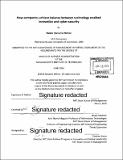How companies achieve balance between technology enabled innovation and cyber-security
Author(s)
Nelson, Natalia (Natalia Natasha)
DownloadFull printable version (16.35Mb)
Other Contributors
Sloan School of Management.
Advisor
Stuart Madnick.
Terms of use
Metadata
Show full item recordAbstract
With increasing economic pressures and exponential growth in technological innovations, companies are increasingly relying on digital technologies to fulfill their innovation and value creation agendas. At the same time, based on the increasing levels of cyber-security breaches, it is clear that the trustworthiness of many established and new technologies is not yet well addressed or appreciated as a fundamental core value in the new digital economy. Consequently, companies are aggressively pursuing strategies to increase cybersecurity of their existing and new digital assets. Many ClOs are faced with having to deal with both of these priorities simultaneously and find them to be frequently conflicting, and creating tensions. This exploratory study first introduces a framework for evaluating these risk/reward trade-offs. Through a survey and a series of interviews, companies are positioned in different quadrants on a digital innovation and cyber-security maturity matrix. This positioning is then overlaid with the perceptual negative impact of cyber-security controls on the innovative projects. The thesis then analyzes the industry level, firm level, technology management and the technology maturity factors that affect this perception and these trade-offs. Ultimately the thesis provides a set of practical recommendations for any company to evaluate their own positioning on the innovation / cyber-security matrix, understand the underlying factors that affect that position and how to better manage these trade-offs.
Description
Thesis: M.B.A., Massachusetts Institute of Technology, Sloan School of Management, 2016. Cataloged from PDF version of thesis. Includes bibliographical references (pages 117-120).
Date issued
2016Department
Sloan School of ManagementPublisher
Massachusetts Institute of Technology
Keywords
Sloan School of Management.